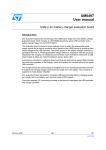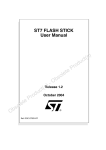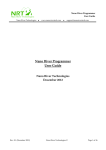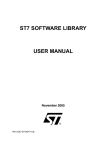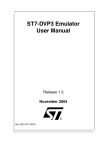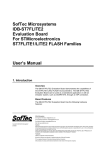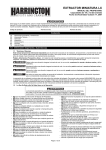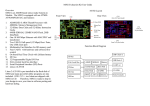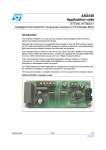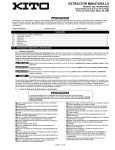Download EVBST7-DISK User`s manual
Transcript
Evaluation board for microcontrollers ST7LITE and ST72F26x. User Manual REV 1.0 , lu ard ST Sta rve a e , o Ev B VR ers b S d l n io 1, A trol We mo t i a ‘5 in ron ed r c fo cro dd s M the e s d e i m mb oar rs, peC E B e S PI its ng roll gh r K pi nt Hi fo r y o rte tot roc FID ers s o c r Pr mi s, R mm lle rs or ler gra tro f ol n o s pr oco CB e ntr l u o m icr s, P for c e t t m m ds s e ne Sy T st oar lS n y I , s B tro C d I r e P o tion con eb s , R ce lua cro W V A pro va mi ed iro g E IC edd m c i s M nin T, P mb rd , a s g si , S its E Bo ller e d VR K ng ro A ter pi nt igh , y o r t 1 H ‘5 Sta oto roc ID c r e rs P mi RF m e s l , r er fo ers ram trlv g n r s ll Se ule tro pro oco od con ms icr s, m ni net ste T m stem er Sy , S sy Bo h et d In PIC sor on e , ce ati ic e R m o u Sp AV opr val IC e r r fo ic g E T, P mb rs s M nin , S E g s r t g R i i in le ol des , AV er K typ B `51 tart roto roS s P mic , PC for s s ller er for lers d l ar tro erw les tro on b S du con ram c ro We imo et rog p co d in ern e o M m dd ds eth ste icr ar rs, Sy T m r o B olle In , S so tr ed IC oce ign P s co Spe R, opr De V cr h B Rtion ig r A Mi C a H f o rs , Pone asolution lu Many ideas s e s l v s m er ol m ntr ste g E ard co Sy nin Bo 1. Introduction EVBST7-DISK is a development board designed for the hobbyists and engineers who want easily prototype their system based on ST7LITE and ST72F26x microcontrollers from STMicroelectronics. This board allows implementing engineer’s idea without a hitch. Developer has access to all pins all processors and peripherals devices, which are connected to the header (pin connectors). There are six sockets for microcontrollers (which every microcontroller is independent) and peripheral devices like: thermometer, relays, potentiometers, eight buttons and eight LED’s, real time clock, interface RS232, FLASH memory, LED displays and optionally assembled LCD (2 x 16 symbols) on board. The board contains also a power supply which relieves the user from the need to provide a regulated supply voltage. This board comes with the several examples of the C code routines (source form), to facilitate testing and quick development in using the board’s resources. We wish great success and full satisfaction while designing and constructing appliances based on EVBST7-DISK Features: - 6 sockets for microcontrollers - connectors of all peripherals accessible on board - power supply circuit - port RS232 - independent programming connectors - socket for LCD 2x16 - 2 potentiometers - 8 buttons - real time clock - Flash memory - 8 LEDs - 4 LED displays - buzzer 2 2. Board layout 1 1 1 2 2 2 2 1 16 10 9 8 7 6 5 4 3 2 1 15 14 13 12 11 10 9 8 7 6 5 4 3 2 1 10 9 8 7 6 5 4 3 10 9 2 1 8 7 6 5 4 3 2 1 1 10 9 2 17 8 7 18 19 20 21 22 23 24 25 26 27 28 29 30 31 32 2 6 5 4 3 1 2 10 9 8 7 6 5 1 2 2 2 1 1 4 3 2 1 1 1 2 2 1 2 25 23 21 19 17 15 13 11 9 7 5 3 1 26 24 22 20 18 16 14 12 10 8 6 4 2 1 2 1 1 10 9 8 7 6 5 4 3 2 1 1 2 2 2 1 1 2 1 1 8 2 7 9 2 10 6 11 5 12 4 3 13 2 14 1 10 9 8 7 6 5 4 3 2 4 1 3 2 1 10 9 8 7 6 5 4 3 2 8 7 6 5 4 3 2 1 20 9 10 11 12 13 14 15 16 1 2 1 1 1 1 2 2 2 15 16 11 12 13 14 15 16 17 18 19 20 5 6 7 8 11 12 13 14 15 16 17 18 19 1 2 8 7 6 5 4 3 2 1 19 17 15 13 11 9 7 5 3 1 7 5 3 1 10 9 8 7 6 5 4 3 2 1 15 13 11 9 7 5 3 1 16 15 14 13 12 11 10 9 20 18 16 14 12 10 8 6 4 2 8 6 4 2 20 19 18 17 16 15 14 13 12 11 16 14 12 10 8 6 4 2 4 3 2 1 7 5 3 1 11 9 7 5 3 1 7 5 3 1 9 7 5 3 1 5 3 1 5 3 1 5 3 1 11 9 7 5 3 1 2 8 7 6 5 8 6 4 2 12 10 8 6 4 2 8 6 4 2 10 8 6 4 2 6 4 2 6 4 2 6 4 2 12 10 8 6 4 2 1 1 BO1 2 1 6 3 2 7 3 2 8 2 1 2 3 2 3 5 4 5 4 2 3 4 5 6 7 8 9 10 11 12 13 14 15 1 4 16 9 1 5 1 3 2 BO2 3 1 1 1 1 2 1 2 2 1 2 1 2 2 1 0 2 3 1 1 0 2 3 2 0 0 1 1 2 3 1 10 9 8 7 6 10 9 8 7 6 10 9 8 7 6 10 9 8 7 6 1 2 1 2 1 1 2 3 4 5 1 2 3 4 5 1 2 3 4 5 1 2 3 4 5 2 1 3 4 2 1 3 2 1 3 2 3 4 1 3 4 3 1 2 4 3 1 2 2 4 3 4 4 1 3 4 1 2 1 3 1 2 1 3 3 2 1 4 2 2 Fig.1 Component location on EVBST7-DISK 1. Socket for ST7226x microcontroller 2. Socket for ST7LITE1xB microcontroller 3. Socket for ST7LITE3 microcontroller 4. Socket for ST7UltraLite microcontroller 5. Socket for ST7LITE2 microcontroller 6. Socket for ST7LITE0x and ST7SuperLite microcontroller 7. Connector with all terminals of ST7226x 8. Connector with all terminals of ST7LITE1xB 9. Connector with all terminals of ST7LITE3 10. Connector with all terminals of ST7UltraLite 11. Connector with all terminals of ST7LITE2 12. Connector with all terminals of ST7LITE0 i ST7UltraLite 13. Programming connector for ST7LITE1xB 3 14. Programming connector for ST7LITE3 15. Programming connector for ST7UltraLite 16. Programming connector for ST7226x 17. Programming connector for ST7LITE2 18. Programming connector for ST7LITE0 i ST7SuperLite 19. Quartz crystal and jumpers for ST7LITE1xB 20. Quartz crystal and jumpers for ST7LITE3 21. Quartz crystal and jumpers for ST7226x 22. Quartz crystal and jumpers for ST7LITE2 23. Connectors of all peripherals 24. Terminal blocks connected to relays contacts 25. Relays 26. Potentiometer for LCD contrast 27. Battery charging jumpers 28. Connector for LCD 2x16 29. Real Time Clock M41T81 30. 8Mbit Flash memory - M45PE80 31. LM317 voltage regulator 32. RS-232 driver / receiver (ST3232) 33. RS-232 port 34. Power supply connector 35. Power switch 36. Buzzer 37. Battery 3,6V 65mAh 38. LED displays 39. RESET button 40. Potentiometers 41. Eight LEDs 42. Thermometer LM35 43. Eight buttons 3. Supported microcontrollers EVBST7-DISK has been prepared for microcontrollers: - ST7226x (SDIP-32) - ST7LITE3 (DIP-20) - ST7LITE2 (DIP-20) - ST7LITE1xB (DIP-16) - ST7LITE0 (DIP-16) - ST7SuperLite (DIP-16) - ST7UltraLite (DIP-8) 4. Board power supply Recommended external power supply voltage is 7-12V AC, or 9-15V DC. A standard power jack (bolt diameter 2.1mm) is provided at the edge of the board. Stabilized voltage VDD is available on the double header and on the prototype area of the board. The selection of the VDD is provided through a 3V3 header. The default voltage VDD is 5VDC (no jumper on 3V3 header). By placing a jumper Vdd becomes 3.3 VDC. 4 The SUPPLY jumper provides power from voltage regulator to devices and microcontrollers. Additionally, each microcontroller has one jumper to provide power supply voltage to microcontroller VDD pin. The jumpers’ names are: PWR ST72, PWR L3, PWR L2, PWR L1xB, PWR L0/S and PWR UL. These additional jumpers where implement to give a possibility of current measure or powering MCU from battery. 5. Microcontrollers circuits There are six sockets on board for microcontrollers marked on Fig.1 as 1, 2… 6, six programming connector for each MCU and four of them have quartz oscillator. Every MCU is connected to own header. This construction allows working with more than one MCU at the same time. 6. Peripheral circuits 6.1. LED’s The board has 8 LED diodes, which make the simplest interface between the system and the user. This is especially useful for the beginners. All diode are connected via resistor to VDD, the diode turns on after grounding of the associated LDn (n = 0 – 8)pin Vdd Vdd R17 1k Vdd R18 1k D0 Vdd R19 1k D1 Vdd R20 1k 1K D2 Vdd R21 1k D3 Vdd R22 1k D4 Vdd R23 1k D5 R24 1k D6 JP8 D7 L1 L3 L5 L7 1 3 5 7 2 4 6 8 L2 L4 L6 L8 L8 L7 L6 L5 L4 L3 L2 L1 LED Fig.2. Implementation of LED’s 6.2. Switches The board is equipped with 8 push-buttons. Pressing one of them causes grounding of the corresponding pin on the KEY header. 5 Vdd Vdd R29 10k Vdd R30 10k K1 Vdd R31 10k K2 S0 Vdd R32 10k K3 S1 Vdd R33 10k K4 S2 Vdd R34 10k R35 10k K5 S3 Vdd K6 S4 R36 10k K7 S5 JP7 K1 K3 K5 K7 K8 S6 S7 1 3 5 7 2 4 6 8 K2 K4 K6 K8 KEY GND GND GND GND GND GND GND GND Fig.3. Implementation of push-buttons 6.3. Relays The board has two relays driven through transistors, where the base of transistor is connected to MISC header and marked as RL1 and RL2. The relays contacts NO, NC, COM, are connected to JP9 and JP11, which allows driving external device. The relay is switching-on after grounding of the associated pin. Vdd Vdd R1 Q2 BC 857 4k7 R2 REL5 Q3 BC 857 4k7 REL8 1 3 5 REL3 GND JP9 JP3 TEM POT2 POT1 RL2 RELAY-SPDT D9 LL4148 REL2 REL6 GND REL4 REL7 RL1 RELAY-SPDT D8 REL1 2 4 6 REL5 REL1 BUZ1 MISC REL3 REL2 REL4 1 2 3 REL2 JP11 REL7 REL6 REL8 1 2 3 REL1 Fig.4. Implementation of relays 6.4. Buzzer The board has a built-in acoustic signaler, controlled by a logic low state through a transistor. The base of the transistor is connected to connector MISC marked as BUZ. 6 R3 BUZ1 4k7 JP3 SPK1 Vdd Q1 BC857 TEM POT2 POT1 1 3 5 2 4 6 REL5 REL1 BUZ1 MISC GND BUZ Fig.5. Connection schematic of buzzer 6.5. Thermometer The board has one temperature sensor LM35. The voltage on output (Vout) is proportional to the gradient of the ambient temperature. Access to Vout is provided by TEM pin of the MISC connector. User can wire this pin to the micro’s A/D input and measure the temperature. GND Vout JP3 TEM POT2 POT1 3 2 1 VCC U1 LM35 1 3 5 2 4 6 REL5 REL1 BUZ1 MISC C1 GND 100n Vdd R6 75R GND TEM Fig.6. Implementation of thermometer 6.6. Potentiometers The board is equipped with two potentiometers, allowing for simulation of the analog circuit outputs. The potentiometers enable the adjustment of voltage in the range 0-Vdd. The potentiometers outputs are accessible on POT1 and POT2 pins of the MISC connector. Vdd Vdd JP3 POT1 R4 5K POT2 R5 5K TEM POT2 POT1 1 3 5 2 4 6 REL5 REL1 BUZ1 MISC GND GND Fig.7. Implementation of potentiometers 7 6.7. RS232 interface There is a DB-9 connector on the board, connected with the ST3232 state converter. On the other side of the converter there is header JP10 with converter circuit terminals, allowing connecting to the processor. GND Vdd C6 100n C7 1 2 3 4 5 6 7 8 100n C9 100n C10 100n C8 U3 C1+ V+ C1C2+ C2VT2out R2in ST3232 JP12 GND 16 15 14 13 12 11 10 9 VCC GND T1out R1in R1out T1in T2in R2out 1 6 2 7 3 8 4 9 5 100n GND TxD RxD JP10 RxD TxD 1 2 RS232 RS 232C GND Fig.8. Connection of converter to DB-9 connector and header 6.8. Real Time Clock M41T81 and battery The board is equipped with real time clock with battery back-up. The RTC communicate with MCU via I2C interface, all M41T81 pins are connected to RTC header. On this header on VBAT pin constructor can directly measure battery voltage. Vdd X1 C26 BAT J1 LOAD D10 GND D11 SS14 R8 150R J23 QL GND VBAT SS14 R69 150R 32.768kHz U2 OSCI OSCO Vbat Vss 100n Vcc FT/OUT SCL SDA VRTC FT SCL SDA R9 4K7 R10 4K7 R11 4K7 VRTC GND 1 3 5 8 7 6 5 RTC_M41T81 BAT1 GP60BVH JP26 JP2 SDA FT Vdd 1 2 3 4 2 4 6 RTC SCL VBAT VRTC BAT BAT BAT BAT 1 2 3 4 5 6 7 8 BAT BAT BAT BAT BAT Fig.9. Real Time Clock circuit. User has to connect 5 and 6 pin on JP2 to power the RTC from board VDD, or connect by wire VRTC pin with one pin on JP26 to power it from battery. Data Sheet of M41T81 user can find on www.st.com/rtc web site. On all pins of BAT header are connected though diode D11 to battery, from where can power for example MCU or Flash. The battery can be charging with direct 8 current through LOAD jumper. QL jumper is implementing to quick charging. User has to be careful to prevent from battery damage in this case. Data Sheet of GP60BVH battery user can find on www.gpbatteries.com web site. CAUTION: User shouldn’t charge/discharge the battery with more than specified current at Data Sheet!!! 6.9. LCD The LCD (2 x 16 characters) socket is connected to JP6 header. The connection method permits only the write operation to the display, which is, however, sufficient for its operation. Contrast adjustment can be regulated by R12 potentiometer, when user will connect pins 1 and 2 on JP6. GND Q4 BC817B JP5 LTGLTG+ D7 D6 D5 D4 D3 D2 D1 D0 E R/W R/S KONTR Vcc GND R7 4K7 16 15 14 13 12 11 10 9 8 7 6 5 4 3 2 1 Vdd JP6 Vdd 10 8 6 4 2 9 7 5 3 1 LCD C2 GND GND Vdd 100n C28 GND LCD_2X16 GND R12 5K Vdd Vdd 100n Fig.10.Schematic of LCD connection Four data lines (D4-D7) and two control lines (R/S, E) are available on JP6 header. Pin no. 9 is used to control LCD backlight through transistor. This pin can be permanently connected to pin no.10. 6.10. FLASH memory The M45PE80 is a 8Mbit (1M x 8 bit) Serial Paged Flash Memory accessed by a high speed SPI-compatible bus (up to 33MHz). One page of memory is storing 256B. Memory supply voltage range is between 2.7V and 3.6V. Because voltage of board power supply may be to 5V, memory is powering passing by LED diode. However the inputs of memory are connected by resistors. When voltage of board power supply is regulated to 3.3V, user can close FLASH PWR jumper to power memory directly (without diode). 9 SWH_3 FLASH PWR D13 C27 Vdd GND R38 R40 R42 R44 D Q C /S R46 Vdd 1 8 2 4 100R 100R 100R 100R 10K U4 100n D Q C /S VCC /RES /W VSS 6 3 5 7 M45PE80 R39 R41 R43 R45 10K 100R 100R 10K /RES /W Vdd GND JP1 C Q D 1 3 5 2 4 6 /RES /S /W FLASH Fig.11. Implementation of Flash memory 6.11. LED displays The board is equipped with four 7-segment LED displays with common anode. All segments are connected to 7SEG (JP4) header through serial resistors, anodes are driven trough transistors. Implementation like this allows to multiplexing control. Vdd R13 LED7_A3 7 LED7_A 6 LED7_B 4 LED7_C 2 LED7_D 1 LED7_E 9 LED7_F 10 LED7_G 5 LED7_DP Q5 BC807B 4K7 LED3 a b c d e f g DP Vdd A A 3 8 R14 LED7_A2 7 LED7_A 6 LED7_B 4 LED7_C 2 LED7_D 1 LED7_E 9 LED7_F 10 LED7_G 5 LED7_DP Q6 BC807B 4K7 LED2 a b c d e f g DP Vdd A A 3 8 R15 LED7_A1 7 LED7_A 6 LED7_B 4 LED7_C 2 LED7_D 1 LED7_E 9 LED7_F 10 LED7_G 5 LED7_DP Q7 BC807B 4K7 LED1 a b c d e f g DP Vdd A A 3 8 R16 LED7_A0 7 LED7_A 6 LED7_B 4 LED7_C 2 LED7_D 1 LED7_E 9 LED7_F 10 LED7_G 5 LED7_DP Q8 BC807B 4K7 LED0 a b c d e f g DP A A 3 8 JP4 LED7_A0 LED7_A2 LED7_A LED7_C LED7_E LED7_G R61 R63 R65 R67 680R 680R 680R 680R 1 2 3 4 5 6 7 8 9 10 11 12 R62 R64 R66 R68 LED7_A1 LED7_A3 680R LED7_B 680R LED7_D 680R LED7_F 680R LED7_DP 7SEG Fig.12. 7-segment LED display connection schematic 10 7. Connectors 7.1. Microcontrollers and peripheral headers 1 2 3 4 5 6 7 8 9 10 11 12 13 14 15 16 17 18 19 20 21 22 23 24 25 26 ST7226x microcontroller’s header PA0-PA7, PB0-PB7, PC0-PC5 – pins of MCU ports OSC1 – microcontroller OSC1/CLKIN pin (input for external clock signal) RST – connected to microcontroller RESET pin VDD – board power supply pin GND – ground ST7LITE3 microcontroller’s header 1 2 3 4 5 6 7 8 9 10 11 12 13 14 15 16 17 18 19 20 1 11 2 12 3 13 4 14 5 15 6 16 7 17 8 18 9 19 10 20 PA0-PA7, PB0-PB6 – pins of MCU ports OSC1– microcontroller OSC1/CLKIN pin (input for external clock signal) RST – connected to microcontroller RESET pin VDD – board power supply pin GND – ground ST7LITE2 microcontroller’s header PA0-PA7, PB0-PB6 – pins of MCU ports OSC1– microcontroller OSC1/CLKIN pin (input for external clock signal) RST – connected to microcontroller RESET pin VDD – board power supply pin GND – ground 11 ST7LITE1xB microcontroller’s header 1 9 2 10 3 11 4 12 5 13 6 14 7 15 8 16 PA0-PA7, PB0-PB4 – pins of MCU ports PC0 – bit no. 0 of optional port C, OSC1, CLKIN (input for external clock signal) PC1 - bit no. 1 of optional port C, OSC2 RST – connected to microcontroller RESET pin VDD – board power supply pin GND – ground ST7LITE0 and ST7SuperLite microcontroller’s header 1 2 3 4 5 6 7 8 9 10 11 12 13 14 15 16 PA0-PA7, PB0-PB4 – pins of MCU ports RST – connected to microcontroller RESET pin VDD – board power supply pin GND – ground ST7UltraLite microcontroller’s header 1 2 3 4 5 6 7 8 PA0-PA5 – pins of MCU port A VDD – board power supply pin GND – ground 7.2. Programming socket 10 9 8 7 6 5 4 3 2 1 ICCOSC – input for clock signal from programmer ICCCLK – programming clock signal ICCDATA – programming data line ICCRESET – reset line from programmer ICCSEL/VPP – this pin is using in ICC protocol and some processors need this line to programming session. VDD_APLI – board power supply pin GND – ground 12 7.3. Peripheral headers 1 5 2 6 3 7 4 8 Battery connector, all pins are connected through Schottky diode to battery (3.6V) Push-buttons S0-S7 header, all pins pulled-up to VDD 1 2 3 4 5 6 7 8 1 2 3 4 5 6 7 8 9 10 11 12 1 2 3 4 5 6 7 8 7-segment displays header A, B, C, D, E, F, G, DP – all segments pins A0-A3 – pins for anodes driving LED’s cathodes pins. 1 2 3 4 5 6 7 8 9 10 1 2 3 4 5 6 LCD header. D7-D4 – data bus R/S – control line data/command E - strobe CNTR – Contrast potentiometer pin VC - LCD contrast line LTG – backlight driving pin VDD- board power supply pin Real Time Clock header. SDA – I2C data line for RTC SCL –I2C clock line RTC VRTC – RTC power supply pin VDD - board power supply pin FT – depends of RTC configuration (look at RTC Data Sheet) 13 1 2 3 4 5 6 2 FLASH memory SPI interface header. C – SPI clock line Q – SPI serial output D – SPI serial input /S – FLASH chip select /W – write protect pin /RES – reset pin RS-232 state converter’s header TXD – transmit line RXD – receive line 1 1 2 3 4 5 6 7 8 9 10 11 12 Common reset signal header RST – pins connected to RESET push-button L0 – RESET pin of ST7LITE0 lub ST7SuperLite MCU ST72 – RESET pin of ST7226x MCU L2 – RESET pin of ST7LITE2 MCU UL – RESET/PA3 pin of ST7UltraLite MCU L3 – RESET pin of ST7LITE3 MCU L1 – RESET pin of ST7LITE1xB MCU CAUTION: User has to be careful with connecting UL pin to RST pin, because RESET pin at UltraLite microcontroller could be configured as port 1 2 3 4 5 6 Others peripheral pins REL1,2 – relays driving pins POT 1,2– potentiometer adjustment pins TEM – analog thermometer pin BUZ – buzzer driving pin 7.4. Relays contact connector NO – normal open contact NC – normal closed contact COM – common contact 14 8. Jumpers 3V3 – when closed causes 3.3V at board power supply, otherwise the power supply is 5V SUPPLY – when closed regulated voltage is provided from local power supply circuit FLASH PWR– closed when voltage of power supply is 3.3V, when 5V this jumper should be open PWR ST72, PWR L3, PWR L3, PWR L1xB, PWR L0/S, PWR UL – these jumpers when closed are providing board power supply to microcontrollers ICP PWR – this jumper is used to provide power supply for ICPcable I programmer when user wants to program ST7UltraLite microcontroller when power supply is off OSC1 and OSC2 – these jumpers are used to closing X2 quartz pins to ground when internal oscillator for ST7226x is used; in case when external clock source is connected to pin OSC1, only OSC2 jumper should be closed; when using X2 quartz both jumpers should be open OSC3, OSC4 and CLKIN2 – jumpers OSC3 and OSC4 are using to closing X3 quartz pins to ground when internal oscillator for ST7LITE1xB is used; In case when external clock source is used (connected to OSC1 or PB4 pin) the jumper OSC3 should be closed; When external clock source will be delivered through programming connector, user has to close CLKIN2 jumper (external clock will be connected to PB4/CLKIN pin) or close pins between CLKIN2 and OSC4 (external clock will be connected to OSC1/CLKIN pin) as on picture below 2 2 1 1 1 2 When ICP OPT Disable mode is used to programming MCU, clock source from programmer has to be connected to PB4 through CLKIN2 OSC7, OSC8 and CLKIN4 – jumpers OSC7 and OSC8 are using to closing X5 quartz pins to ground when internal oscillator for ST7LITE3 is used; In case when external clock source is used (connected to OSC1 or PB4 pin) the jumper OSC7 should be closed; When external clock source will be delivered through programming connector, user has to close CLKIN4 jumper (external clock will be connected to PB4/CLKIN pin) or close pins 15 between CLKIN4 and OSC8 (external clock will be connected to OSC1/CLKIN pin) as on picture below 2 2 1 1 1 2 When ICP OPT Disable mode is used to programming MCU, clock source from programmer has to be connected to PB4 through CLKIN4. OSC5, OSC6 and CLKIN3 – jumpers OSC5 and OSC6 are using to closing X4 quartz pins to ground when internal oscillator for ST7LITE2 is used; In case when external clock source is used (connected to OSC1 or PB4 pin) the jumper OSC5 should be closed; When external clock source will be delivered through programming connector, user has to close CLKIN3 jumper (external clock will be connected to PB4/CLKIN pin) or close pins between CLKIN3 and OSC6 (external clock will be connected to OSC1/CLKIN pin) as on picture below 2 2 1 1 1 2 When ICP OPT Disable mode is used to programming MCU, clock source from programmer has to be connected to PB4 through CLKIN4. CLKIN5 – when this jumper is closed external clock source is connected from ICP_UL programming connector to PA5/CLKIN ST7UltraLite pin. CLKIN1 - when this jumper is closed external clock source is connected from ICP_L0 programming connector to PA5/CLKIN pin of ST7Lite0 or ST7SuperLite POWER diode – when this diode is shining, the power is connected to VDD. 16 9. Demo software LCD.c displays scrolling string on the LCD panel LED_ADC.c potentiometer setting is displayed by a pattern of the LED diodes LED.c pressing one of the switches turns on a pattern of LED lights 17 10. Schematic diagram JP13 JP14 GND 1 3 5 7 9 Vdd OSC1_72 2 4 6 8 10 Vdd RESET_72 OSC1_72 PB7_72 PB6_72 PB5_72 PB4_72 PB3_72 PB2_72 PB1_72 PB0_72 PC5_72 PC4_72 ICCDATA_72 ICCCLK_72 RESET_72 ICCSEL_72 GND ICP_ST72x OSC1_72 GND RESET_72 C13 22p PB7_72 PB6_72 PB5_72 PB4_72 X2 8MHz C14 22p GND PB3_72 PB2_72 PB1_72 PB0_72 PC5_72 PC4_72 PC3_72 J5 J6 OSC1 OSC2 1 2 3 4 5 6 7 8 9 10 11 12 13 14 15 16 1 3 5 7 9 11 13 15 17 19 21 23 25 2 4 6 8 10 12 14 16 18 20 22 24 26 GND PA0_72 PA1_72 PA2_72 PA3_72 PA4_72 PA5_72 PA6_72 PA7_72 PC0_72 PC1_72 PC2_72 PC3_72 JP15 GND Vdd ICCOSC_L0 RESET Vdd OSC1 Vss OSC2 ICCSEL PB7/SS ICCCLK/PA0 PB6/SCK ICCDATA/PA1 PB5/MISO PA2 PB4/MOSI PA3 NC NC NC NC PB3/OCMP2_A SCLI/PA4 PB2/ICAP2_A RDI/PA5 PB1/OCMP1_A SDAI/PA6 PB0/ICAP1_A TDO/PA7 PC5/EXTCLK_A/AIN5 AIN0/ICAP1_B/PC0 PC4/OCMP2_B/AIN4 AIN1/OCMP1/PC1 PC3/ICAP2_B/AIN3 AIN2/MCO/PC2 2 4 6 8 10 ICCDATA_L0 ICCCLK_L0 RESET_L0 GND ICP_L0x GND PINS ST72x U5 JP16 1 3 5 7 9 32 31 30 29 28 27 26 25 24 23 22 21 20 19 18 17 GND C11 100n Vdd PWR ST72 J3 PA2_72 PA3_72 R49 4K7 R50 4K7 RESET_L0 PB0_L0 PB1_L0 PB2_L0 PB3_L0 PB4_L0 PA0_72 PA1_72 ICCCLK_72 ICCDATA_72 PA4_72 PA5_72 PA6_72 PA7_72 PC0_72 PC1_72 PC2_72 U6 1 2 3 4 5 6 7 8 GND GND 2 4 6 8 10 12 14 16 PA0_L0 PA1_L0 PA2_L0 PA3_L0 PA4_L0 PA5_L0 PA6_L0 PA7_L0 PINS LITE0x/Sx J2 PWR L0/S 100n ICCSEL_72 R47 10k 1 3 5 7 9 11 13 15 Vdd C12 GND GND Vdd RESET_L0 PB0_L0 PB1_L0 PB2_L0 PB3_L0 PB4_L0 VSS LTIC/PA0(HS) VDD PA1(HS) RESET ATPWM0/PA2(HS) PB0/AIN0/SS PA3(HS) PB1/AIN1/SCK PA4(HS) PB2/AIN2/MISO ICCDATA/PA5(HS) PB3/AIN3/MOSI MCO/ICCCLK/PA6 PB4/AIN4/CLKIN PA7 16 15 14 13 12 11 10 9 PA0_L0 PA1_L0 PA2_L0 PA3_L0 PA4_L0 ICCDATA_L0 R48 4K7 R51 4K7 PA5_L0 PA6_L0 PA7_L0 ST7LITE0 ST7LITES ICCCLK_L0 J4 ICCOSC_L0 CLKIN1 ST7226x GND JP17 1 3 5 7 9 Vdd ICCOSC_L1 GND 100n ICCDATA_L1 ICCCLK_L1 RESET_L1 GND ICP_L1xB Vdd J7 PWR L1xB C15 2 4 6 8 10 1 2 3 4 5 6 7 8 GND RESET_L1 PB0_L1 PB1_L1 PB2_L1 PB3_L1 PB4_L1 JP18 1 2 3 4 5 6 7 8 9 10 11 12 13 14 15 16 PC0_L1 PC1_L1 PA0_L1 PA2_L1 PA4_L1 PA5_L1 PA6_L1 PA7_L1 JP20 GND Vdd ICCOSC_L2 X3 8MHz PA0_L1 PA2_L1 PA4_L1 GND PA7_L1 J10 J12 R54 R55 4K7 4K7 OSC4 11 12 13 14 15 16 17 18 19 20 ICCOSC_L2 J8 CLKIN3 C19 22p OSC3 ICCCLK_L1 PA6_L1 PA5_L1 ICCDATA_L1 GND 1 2 3 4 5 6 7 8 9 10 PINS LITE2x GND ST7LITE1xB J11 CLKIN2 ICCOSC_L1 ICCDATA_L2 ICCCLK_L2 RESET_L2 22p C16 PC0_L1 PC1_L1 16 15 14 13 12 11 10 9 VSS OSC1/CLKIN/PC0 VDD OSC2/PC1 RESET LTIC/PA0(HS) PB0/AIN0/SS/COMPIN+ ATPWM0/PA2(HS) PB1/AIN1/SCK ATPWM2/PA4(HS) PB2/AIN2/MISO ATPWM3/ICCDATA/PA5(HS) PB3/AIN3/MOSI MCO/ICCCLK/BREAK/PA6 PB4/AIN4/CLKIN/COMPIN- COMPOUT/PA7(HS) 2 4 6 8 10 ICP_L2x PINS LITE1xB U7 1 3 5 7 9 GND OSC1_L2 PB0_L2 PB1_L2 PB2_L2 PB3_L2 PB4_L2 PB5_L2 PB6_L2 PA7_L2 PB4_L2 R52 PA6_L2 ICCCLK_L2 ICCDATA_L2 PA5_L2 R53 1 2 3 4 5 6 7 8 9 10 PB2_L2 PB3_L2 PB5_L2 PB6_L2 PA7_L2 4K7 PA4_L2 PA3_L2 4K7 GND U8 PB2/MIS0/AIN2 SCK/AIN1/PB1 PB3/MOSI/AIN3 SS/AIN0/PB0 PB4/CLKIN/AIN4 RESET PB5/AIN5 Vdd PB6/AIN6 Vss PA7 CLKIN/OSC1 PA6/MCO/ICCCLK/BREAK OSC2 PA5/ATPWM3/ICCDATA LTIC/PA0 PA4/ATPWM2 ATIC/PA1 PA3/ATPWM1 ATPWM0/PA2 Vdd GND RESET_L2 PA0_L2 PA1_L2 PA2_L2 PA3_L2 PA4_L2 PA5_L2 PA6_L2 Vdd J9 20 19 18 17 16 15 14 13 12 11 PB1_L2 PB0_L2 RESET_L2 GND 22p C18 C17 100n GND GND X4 8MHz GND PA0_L2 PA1_L2 PA2_L2 ST7LITE2 C20 22p J13 OSC1_L2 OSC5 J14 GND OSC6 JP21 GND 1 3 5 7 9 Vdd ICCOSC_L3 JP22 2 4 6 8 10 ICCDATA_L3 ICCCLK_L3 RESET_L3 GND ICP_L3x Vdd GND C25 100n GND PB4_L3 PB5_L3 PB6_L3 J21 CLKIN4 1 3 5 7 9 11 13 15 17 19 2 4 6 8 10 12 14 16 18 20 GND OSC1_L3 PA0_L3 PA1_L3 PA2_L3 PA3_L3 PA4_L3 PA5_L3 PA6_L3 PA7_L3 1 2 3 4 5 6 7 8 9 10 U9 VSS CLKIN/OSC1 VDD OSC2 RESET LTIC/PA0(HS) PB0/SS/AIN0 ATIC/PA1(HS) PB1/SCK/AIN1 ATPWM0/PA2(HS) PB2/MISO/AIN2 ATPWM1/PA3(HS) PB3/MOSI/AIN3 ATPWM2/PA4(HS) PB4/CLKIN/AIN4 ATPWM3/ICCDATA/PA5(HS) PB5/AIN5 MCO/ICCCLK/BRAK/PA6 PB6/RDI/AIN6 TDO/PA7(HS) ST7LITE3 OSC1_L3 20 19 18 17 16 15 14 13 12 11 JP23 GND Vdd ICCOSC_UL 2 4 6 8 10 ICCDATA_UL ICCCLK_UL GND R56 3K3 ICP_UL J16 JP24 Vdd PA5_UL PA4_UL PA3_UL 1 3 5 7 2 4 6 8 GND PA0_UL PA1_UL PA2_UL PINS ULTRALITE PA3_UL OSC7 JP25 GND J19 OSC8 C22 22p PA0_L3 PA1_L3 PA2_L3 PA3_L3 PA4_L3 PA7_L3 1 3 5 7 9 J15 ICP PWR J17 PINS LITE3x J18 PWR L3 RESET_L3 PB0_L3 PB1_L3 PB2_L3 PB3_L3 GND Vdd RESET_L3 PB0_L3 PB1_L3 PB2_L3 PB3_L3 PB4_L3 PB5_L3 PB6_L3 GND X5 8MHz C23 22p R59 4K7 R60 4K7 PA5_L3 ICCDATA_L3 ICCCLK_L3 PA6_L3 100n Vdd ICCOSC_UL PA5_UL GND PWR ULC24 GND J20 CLKIN5 PA4_UL PA3_UL 1 2 3 4 U10 VDD VSS PA5(HS)/AIN4/CLKINATPWM/ICCDATA/AIN0/PA0(HS) PA4(HS)/AIN3 ICCCLK/AIN1/PA1(HS) PA3/RESET LTIC/AIN2/PA2(HS) RESET_L0 RESET_72 RESET_L2 PA3_UL RESET_L3 RESET_L1 ICCDATA_UL ICCCLK_UL 8 7 6 5 GND PA2_UL ST7LITEUS RESET GND GND Vdd RESET_L1 PB0_L1 PB1_L1 PB2_L1 PB3_L1 PB4_L1 PWR L2 JP19 1 2 3 4 5 6 7 8 9 10 11 12 C21 100n RESET S_RES1 RESET JP R57 4K7 GND R58 4K7 PA1_UL PA0_UL ICCOSC_L3 18 GND D9 LL4148 GND GND Vdd C1 JP4 LED7_A0 LED7_A2 LED7_A LED7_C LED7_E LED7_G R5 5K POT2 R61 R63 R65 R67 1 2 3 4 5 6 7 8 9 10 11 12 680R 680R 680R 680R R62 R64 R66 R68 680R 680R 680R 680R JP1 LED7_A1 LED7_A3 LED7_B LED7_D LED7_F LED7_DP C Q D 1 3 5 GND TEM JP2 GND SDA FT Vdd 1 3 5 JP6 R69 C28 GND GND Vdd LED7_A3 100n Vdd R18 1k D0 Vdd R19 1k Vdd D1 D2 Vdd R21 1k R20 1k 1K D3 R13 Vdd R22 1k Vdd R23 1k D4 LED7_A LED7_B LED7_C LED7_D LED7_E LED7_F LED7_G LED7_DP R24 1k D5 D6 7 6 4 2 1 9 10 5 4K7 LED3 a b c d e f g DP A A REG1 J22 2 C3 22u L8 L7 L6 L5 L4 L3 L2 L1 SUPPLY GND Vdd R29 10k Vdd R30 10k K1 R31 10k K2 S0 Vdd Vdd R32 10k K3 S1 Vdd R33 10k K4 S2 Vdd R34 10k K5 S3 Vdd R35 10k K6 S4 Vdd R36 10k GND R25 240R 1K R26 820R SWH_2 3V3 R37 1k K8 S6 C4 100n 7 6 4 2 1 9 10 5 Q6 BC807B 4K7 LED2 a b c d e f g DP A A 3 8 IN GND GND GND GND GND D12 POWER GND Vdd /S R46 10K 100R 100R 100R 100R 1 8 2 4 C5 47u R27 33R 3 8 LED7_A LED7_B LED7_C LED7_D LED7_E LED7_F LED7_G LED7_DP 7 6 4 2 1 9 10 5 Q8 BC807B 4K7 LED0 a b c d e f g DP A A 3 8 1 3 5 7 FLASH PWR D13 Vdd 100n U4 VCC /RES /W VSS M45PE80 R39 R41 R43 R45 6 3 5 7 10K 100R 100R 10K K2 K4 K6 K8 2 4 6 8 L2 L4 L6 L8 KEY JP8 L1 L3 L5 L7 1 3 5 7 LED B1 3 2 BRIDGE1 R28 680R REL3 REL2 REL4 SW1 SW SPST 1 2,3 JP_S1 VCC_IN 1 2 3 REL2 JP10 GND GND RxD TxD 1 2 RS232 JP11 100n C9 C10 100n GND REL7 REL6 REL8 Vdd C6 100n 100n /RES /W Vdd 2 4 6 8 JP9 GND C7 GND D Q C /S A A GND GND R38 R40 R42 R44 a b c d e f g DP LED7_A0 BAT BAT BAT BAT JP7 K1 K3 K5 K7 S7 C27 D Q C 7 6 4 2 1 9 10 5 4K7 LED1 R16 5 6 7 8 BAT Vdd Q7 BC807B 1 2 3 4 3 SWH_3 GND R15 LED7_A1 LED7_A LED7_B LED7_C LED7_D LED7_E LED7_F LED7_G LED7_DP REL5 REL1 BUZ1 LM317 OUT GND GND BAT BAT BAT BAT Vdd K7 S5 LED7_A2 LED7_A LED7_B LED7_C LED7_D LED7_E LED7_F LED7_G LED7_DP D7 Vdd Vdd 3 8 R14 2 4 6 MISC Vdd Q5 BC807B 1 3 5 JP26 R11 4K7 Vdd R12 5K 1 GND Vdd 100n R10 4K7 VRTC GND C2 GND R9 4K7 BAT1 GP60BVH TEM POT2 POT1 VRTC FT SCL SDA RTC_M41T81 GND 150R LCD Vdd 150R J23 QL 8 7 6 5 Vcc FT/OUT SCL SDA 4 R17 1k SS14 9 7 5 3 1 JP3 100n OSCI OSCO Vbat Vss ADJ 10 8 6 4 2 R8 U2 1 2 3 4 1 Vdd GND 32.768kHz D11 SS14 VBAT Vdd Vdd SCL VBAT VRTC C26 BAT J1 LOAD D10 LCD_2X16 Vdd X1 R7 4K7 16 15 14 13 12 11 10 9 8 7 6 5 4 3 2 1 2 4 6 RTC Vdd Q4 BC817B LTGLTG+ D7 D6 D5 D4 D3 D2 D1 D0 E R/W R/S KONTR Vcc GND /RES /S /W FLASH GND JP5 2 4 6 7SEG GND 75R 100n R4 5K POT1 R6 GND SPK1 BUZ Vdd GND Vout RL2 RELAY-SPDT 3 RL1 RELAY-SPDT Vdd R3 4k7 VCC REL4 U1 LM35 Q1 BC857 REL3 GND 4k7 REL8 REL2 REL6 D8 Q3 BC 857 REL1 1 4k7 REL7 Q2 BC 857 Vdd R2 REL5 2 Vdd R1 BUZ1 Vdd 1 2 3 4 5 6 7 8 C8 U3 C1+ V+ C1C2+ C2VT2out R2in ST3232 VCC GND T1out R1in R1out T1in T2in R2out 16 15 14 13 12 11 10 9 GND 100n GND TxD RxD JP12 1 6 2 7 3 8 4 9 5 REL1 Cannot open file LogoFINAL_many2.bmp Size: Rev: File: Date: 27-04-2004 19 http://www.propox.com email: [email protected] Title: EVBST7-MB RS 232C GND 1 2 3 Sheet 1 of 1 1.00




















